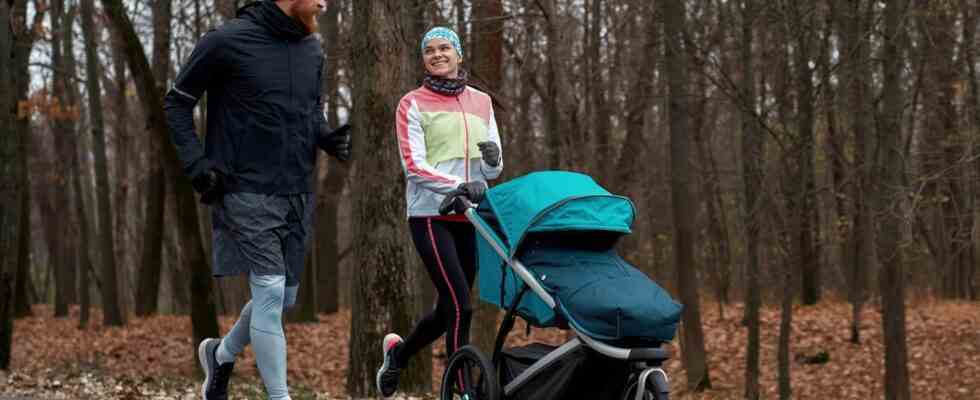No more cold feet
Winter footmuff for the stroller: This is how the trip outdoors is cuddly
A footmuff protects small children from wind and cool temperatures in autumn and winter.
© LanaStock / Getty Images
It’s cuddly, keeps you warm and you don’t want to crawl out again: the winter footmuff. For parents of babies and toddlers, the cuddly mummy is as much a part of the cold season as a scarf and hat. Find out what you should know about winter footmuffs here.
Winter has a firm grip on large parts of Germany. In many places, temperatures have crept towards freezing point. Hat, gloves and a thick jacket are always ready. Long walks have blossomed into a popular hobby for many Germans (also due to the lack of alternatives). This includes those with children. After all, even the little ones are thrown upside down at home – the fresh air strengthens their immune systems. So everyone who is still a little shaky on their feet, can’t walk at all or is just a bit lazy is put in a pram or sports buggy. Because they only sit or lie there, they should be wrapped up as warmly as possible. The winter footmuff is a source of warmth that has proven its worth for winter walks in the freezing cold. The best thing about it: Contrary to its name, it not only protects the feet, but also arms, upper body and optionally even the head.
In this article you will find out what to look out for when buying the cozy footmuff, which material warms best, why belt slots are important and how to take care of a winter footmuff.
Winter footmuff: lambskin, fleece or down?
When it comes to footmuffs for autumn and winter, what matters most is what’s on the inside. The outer shell usually consists of washable artificial fibers, mostly polyester, which should also be windproof. The different models hardly differ here. Inside, parents have three options: lambskin, fleece or down.
- lambskin | Anyone who wants to bed their child in a natural product is on the right track with lambskin. In order to make them usable as a lining for footmuffs or inserts for children’s beds, lambskins are usually medically tanned. You can tell by the slightly yellow color of their fur. This comes from the tanning agents used to disinfect the hides. Big advantage: medically tanned lambskins can be cleaned in the washing machine. Lambskins have the important property of preventing both overheating and cooling down of the body. On the other hand, the soft cuddly skins are quite heavy compared to the down and fleece versions and the smell takes some getting used to.
- fleece | The right choice for everyone who literally wants to wrap their offspring in cotton wool. Padded footmuffs are usually filled with polyester wadding or tiny fiber balls. Not only do they insulate against the bitter cold, they also wick moisture away from the inside of the footmuff. The pack size of these footmuffs is unbeatable. Most fit easily in the stroller basket. The fleece-lined winter footmuffs can also be machine washed. Here they are available
- down | A winter footmuff filled with fluffy down also protects small children from cooling down. So does what it’s supposed to. However, these models are a bit more cumbersome to use. In addition, the down filling is also reflected in the price – especially compared to synthetic fibers. In order to clean the down model or to make it ready for use again after washing, there should be a dryer in the house. Similar to down jackets, feathers tend to clump together when the garment is air dried.
What else should you watch out for?
In order to be able to use the winter footmuff as flexibly as possible, it should have generous and sensibly integrated belt slots for 5 and 3-point belt systems. The footmuff can be easily transferred from the baby seat, stroller or sports buggy to the bicycle trailer – and the child is not only warm, but also safe. The following rule of thumb applies: the more generous the belt slots are, the less fiddly the conversion is. And speaking of fiddly:
Well thought-out zips are also essential for a winter footmuff. You are literally completely carefree with a winter footmuff that is equipped with an all-round zip and, in the best case, with two zips. This not only gives you quick access to the soother you thought you had lost and sorely missed, but you can also transform the winter footmuff into a cuddly soft blanket within seconds. On some models – like this one Kaiser winter footmuff – the lambskin can be unbuttoned and used, for example, for car seats, as a warm pad for buggies or spontaneously as a changing blanket.
Caring for winter footmuffs: This is important
In the ranking of the most easy-care winter footmuffs, the models are outSynthetic fibers such as fleeceundisputed number 1. They can be machine washed at 40 degrees without hesitation (ideally turn inside out), dry quickly and are quickly ready for use again.
Tip: Use mild detergent and avoid fabric softener!
It gets a bit trickier and, above all, more time-consuming with winter footmuffs that are lined with down or (Merino) lambskin are fed. The good news: skins have a self-cleaning effect and don’t have to be washed at the first small stain. When the time comes, they should be cleaned at a maximum of 30 degrees on a wool cycle and later gently dried in the dryer. The natural material then has to be kneaded and shaped while it is still slightly damp.
Danger: Never lay lambskins on a heater or in the sun to dry.
Also at 30 degrees, but on a gentle cycle, should Down footmuffs getting cleaned. Here, too, fabric softener has no place in the drum. If you don’t have a dryer, then hang the footmuff up to dry – but you should shake it up several times so that the down is evenly distributed again.
Tip: Put two or three tennis balls in the dryer. This prevents the down from clumping in the footmuff.
Practical extras for a winter footmuff
- Integrated transport bag
- Reflective strips or prints for better visibility at dusk
- rubberized coating on the underside so that the winter footmuff does not slip in the buggy or pram
- Drawstring in the head area to protect the head even better
Finally, a tip on the size of the winter footmuff. Models that are supposed to fit in a pram or baby seat should not be longer than 85 centimeters. The footmuffs for buggies or sports seats are usually between 90 and 100 centimeters long.
Sources: “lammfellhaus.de”; “wishchild.at”
You might also be interested in:
This article contains so-called affiliate links. Further information are available here.



